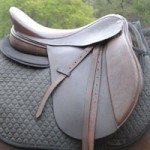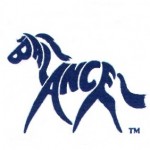 Saddle comfort is imperative for ridden horses. Horses need to be comfortable and their back needs to be unrestricted so that they can use their backs and bodies in a healthy biomechanical way. You might liken saddle fit to how your shoes fit. Shoes that are too tight, too big and move or rub are going to be very uncomfortable and could even be painful. Some shoes will help you to be athletic and others will be quite restrictive. I have seen badly fitting saddles be the cause of many behavioural and training problems in horses which had previously been put down to bad manners, disrespect, bad attitudes or just their nature to be impulsive or lazy. I have seen people spend hours and hours riding, spend hundreds and even thousands of dollars on lessons with horses going through hell in the process, as people tried to train them to use their bodies well, be engaged and be athletic when the biggest problem was an ill-fitting saddle. Once the saddle problem was rectified the horse could simply and easily do and often would “offer” what the rider was asking. Once I saw this I knew how important saddle comfort really was and I also realised how much misinformation there was about saddle fit because many of the people in those situations had purchased expensive saddles and had been given professional advice about saddle fit. Sometimes improving a saddle’s comfort for the horse and rider is as simple as making some adjustments with padding arrangements, adjusting the gullet, or adjusting the flocking if that is a possibility. It does not always mean purchasing a new saddle.
Saddle comfort is imperative for ridden horses. Horses need to be comfortable and their back needs to be unrestricted so that they can use their backs and bodies in a healthy biomechanical way. You might liken saddle fit to how your shoes fit. Shoes that are too tight, too big and move or rub are going to be very uncomfortable and could even be painful. Some shoes will help you to be athletic and others will be quite restrictive. I have seen badly fitting saddles be the cause of many behavioural and training problems in horses which had previously been put down to bad manners, disrespect, bad attitudes or just their nature to be impulsive or lazy. I have seen people spend hours and hours riding, spend hundreds and even thousands of dollars on lessons with horses going through hell in the process, as people tried to train them to use their bodies well, be engaged and be athletic when the biggest problem was an ill-fitting saddle. Once the saddle problem was rectified the horse could simply and easily do and often would “offer” what the rider was asking. Once I saw this I knew how important saddle comfort really was and I also realised how much misinformation there was about saddle fit because many of the people in those situations had purchased expensive saddles and had been given professional advice about saddle fit. Sometimes improving a saddle’s comfort for the horse and rider is as simple as making some adjustments with padding arrangements, adjusting the gullet, or adjusting the flocking if that is a possibility. It does not always mean purchasing a new saddle.
How do we know if a saddle is comfortable and functional for your horse?
A Functional Saddle allows horses to move with healthy biomechanics. So to ascertain whether a saddle is functional requires good knowledge of equine biomechanics. Ultimately it is about allowing the horse to be the judge by offering the horse options in saddles and padding arrangements and observing their response. This is where the knowledge of biomechanics comes in because we need to know what we are looking for in terms of balance, straightness, impulsion and how the horse uses their body. The horse’s mental and emotional state and the expression on their face will also give feedback. There is a lot of misguided information about saddle fitting mainly because most people do not understand healthy biomechanics for the horse and also because many people have not taken into account that a saddle that is made to fit a horse’s static shape (standing still) will not fit the horse’s moving shape and also many saddles are fitted to match a compromised and dysfunctional back and body shape. To get feedback about how well a saddle works for the horse, the horse really needs to be ridden in the saddle. It is important we get the horse’s feedback not just a humans opinion.
Functional Saddling – means using a saddle that doesn’t fit. It doesn’t fit a static or dysfunctional body shape.
We don’t want the saddle to fit the static, standing still, dropped down, resting shape of a horses back and we don’t want the saddle to fit the poor postured, down hill, muscle atrophied or any other form of dysfunctional back. Fitting saddles to these shapes will not allow or encourage horses to lift their backs in an engaged state. When the horse lifts its back in an engaged way, the back expands – it lifts, flattens, straightens and the shoulder blades need to be able to smoothly glide back. Functional saddling takes all this into account. In some cases horses may need a remedial program to recover if their back is very compromised. The use of a great padding system which is also very user friendly, is an important aspect of a Functional Saddling System, and this also makes it easy to make adjustments as horses change and often for the same saddle to be used between several horses if they are not too different in their back shape.
When offering a horse options to try to get their feedback about saddles we must make sure that we are offering good options for comparison. There are certain design features that we have discovered horses like and also certain things to look for in positioning and balancing the saddle which are going to be important to know for this process. In the Equine Biomechanics and Saddle Fitting lecture /demonstrations that I present people can quickly and easily learn what to look for. I like to use saddles from the BALANCE saddle range as comparisons because to date they are the best saddles I have come across.
BALANCE saddles
I have been using BALANCE saddles for more than 20 years now and they have continued to evolve in that time and to date I still have not come across a better saddle for horses and riders. They continue to impress me every time I ride in them or observe horses moving in them. BALANCE saddles are a range of saddles designed by people who understand horse and rider biomechanics. They developed their brand of saddles about 30 years ago when they couldn’t find saddles to meet their requirements and have been pioneers in the saddling industry with other saddle companies following suit. The BALANCE Saddling System has a growing reputation for changing horses with poor, or uninspiring movement into horses with generous, and even spectacular, movement. This simple and logical approach simply removes the blocks and obstacles from the horse and allows, with the support of the rider, their natural talents to come to the fore. You can find out more about the saddles at www.balanceinternational.com
I am a consultant for the BALANCE saddle Company. I carry a range of their saddles and can assist you to try the saddles to see if they suit you and your horse and if so can help you choose which BALANCE saddle is the ideal one for both you and your horse. However a Functional Saddling consultation is not about trying to sell you a BALANCE saddle. It is about finding a way to help you and your horse be more comfortable together, whatever way we can and whatever your budget.
Individual saddle fitting sessions
You may already suspect that your current saddle is not supporting your horse’s needs and are looking to find ways to improve it or find an alternative saddle, or you may just want to reassure yourself that your current saddle is the best option, by offering your horse a comparison.
These saddle fitting session take 1.5 – 2 hrs. We don’t want to rush this as it is so important to get this right. We want to have lots of time to experiment and explain things. To begin you ride in your current saddle and then we look at what we may be able to do padding wise or by changing gullets (if possible), or change flocking (which I can’t do on the spot – but can make recommendations for what needs to be done and where to send it) to improve your existing saddle. I then would have you ride in one of the BALANCE saddles to observe the quality of movement your horse offers which can then be used as a comparison to gain information about how your current saddle is affecting your horse.
If your horse did go better in the BALANCE saddle and you were interested in possibly purchasing a BALANCE saddle you could then try several other BALANCE saddles to find which one best suited both you and your horse.
To see when I am in your area to book a saddle fitting go to the course schedule page as with prior notice I can usually fit in saddle fittings before and after courses. For more information about saddle fitting, BALANCE saddles, or to book a group Saddle Fitting & Equine Biomechanics lecture/demonstration or a private saddle fitting session contact Mel
